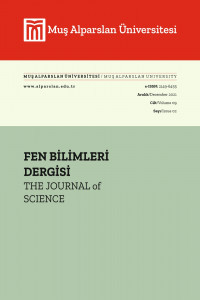KANADA’DA YETİŞEN İKİ Thuja L. (CUPRESSACEAE) TÜRÜNÜN UÇUCU YAĞ KOMPOZİSYONU
Thuja occidentalis; Tetraclinis articulate; uçucu yağ; HS-SPME
-
___
- Chang, L.C., Song, L.L., Park, E.J., Luyengi L., Lee K.J., Fransworth, N.R., Pezzuto, J.M., Kinghorn A.D., Journal of Natural Product, 63, 1235-1238, 2000.
- Millspaugh, C.F., American medicinal plants: An illustrated and descriptive guide to plants indige- nous to and naturalized in the United States are used in medicine. Dover Publications, New York, 1974.
- Assadi, M., Flora of Iran, 11-12, 1998.
- Chen, Y., Li, S., Yang, L., Jiang, Z., Comparative study on chemical constituents of essential
- oils from several parts of Platycladus orientalis (L.) Franco. Linchan Huaxue Yu Gongye, 4, 1-11, 1984.
- Li, Z., Liu, S., Chemical constitution of essential oil from the fruit of Biota orientalis (L.) Endl., Zhongguo Yaoxe Zazhi, 32, 138-139, 1997.
- British Herbal Pharmacopoeia, Thuja, British Herbal Medicine Association,West Yorks, UK, 210-211, 1983.
- Shimada, K., Contribution to anatomy of the central nervous system of the Japanese upon the vermal arbour vitae. Okajimas Folia Anat Jpn., 28, 207-227, 1956.
- Naser, B., Bodinet, C., Tegtmeier, M., Lindequist, U., Thuja occidentalis (Arbor vitae): A review of its pharmaceutical, pharmacological and clinical properties. Alternatif Medical, 2, (1), 69-78, 2005.
- Arctander St.: Perfume and Flavor Chemicals (Aroma Chemicals). Arctander Publ., Montclair, 1969.
- Bauer, K., Garbe, D., Surburg, H., Common Fragrance and Flavour Materials, 3rd Ed., VCH, Weinheim, 1997.
- Verzera, A., Zino, M., Condurso, C., Romeo, V., Zappala, M., Anal. Bioanal. Chemistry, 380, 930-936, 2004.
- Van Den Dool, H., Kratz, P. D., A generalization mof the retention index system including linear temperature programmed gas-liquid partition chromatography, Journal Chromatography, 11, 463-471, 1963.
- Nickavar, B., Amin, G., Parhami, S., Volatile Constituents of the fruit and leaf oils of Thuja orientalis L. Grown in Iran. Z. Naturforsch, 58c, 171-172, 2003.
- Guleria, S., Kumar, A., Tiku, AK., Chemical composition and Fungitoxic Activity of Essential Oil of Thuja orientalis L. Grown in the North-Western Himalaya. Z. Naturforsch, 63c, 211-214, 2008.
- Kılıç, O., Koçak, A.,.Essential Oil Composition of Six Pinus L. Taxa (Pinaceae) from Canada and their chemotaxonomy. Journal of Agricultural Science and Technology B 4 January, 67-73, 2014.
- Kılıç, O., Koçak, A.,. Volatile Constituents of Juniperus communis L., Taxus Canadensis Marshall. and Tsuga canadensis (L.) Carr. From Canada, Journal of Agricultural Science and Technology B 4, January, 135-140, 2014.
- ISSN: 2147-7930
- Yayın Aralığı: Yılda 2 Sayı
- Başlangıç: 2013
- Yayıncı: Muş Alparslan Üniversitesi
OESTRUS OVİS (SHEEP BOT FLY), EKSTERNAL OFTALMOMİYAZİS: BİR OLGU SUNUMU
Hakan USLU, İlknur SALMAN, Mehmet COŞKUN, Can PINAR, Önder AKKAŞ
MUŞ İLİNDE HAYVAN POTANSİYELİNİN DEĞERLENDİRİLEREK BİYOGAZ ÜRETİMİNİN ARAŞTIRILMASI
KANADA’DA YETİŞEN İKİ Thuja L. (CUPRESSACEAE) TÜRÜNÜN UÇUCU YAĞ KOMPOZİSYONU
MUŞ VE BİTLİS YÖRESİNDE TOPLANAN BAL VE PROPOLİSİN ANTİMİKROBİYAL AKTİVİTESİNİN ARAŞTIRILMASI
Yusuf ALAN, Ekrem ATALAN, Nurcan ERBİL, Orhan BAKIR, Zümrete ORMAN, Pelda KANİK
YÜKSEK ENERJİLİ ELEKTRON DEMETLERİ ÖLÇÜMLERİNDE İKİ FARKLI İYON ODASININ KARŞILAŞTIRILMASI
Hasan YENER, Abdülmecit CANBOLAT, Eser BİLEN, Sinan YAŞAR
Ali YILMAZ, Yalçın DİCLE, Abdulalim AYDIN, Yaşar GÖZ
İlknur ÖZGENÇLİ, Yusuf TEMEL, Mehmet Çiftçi, Ömer Küfrevioğlu
